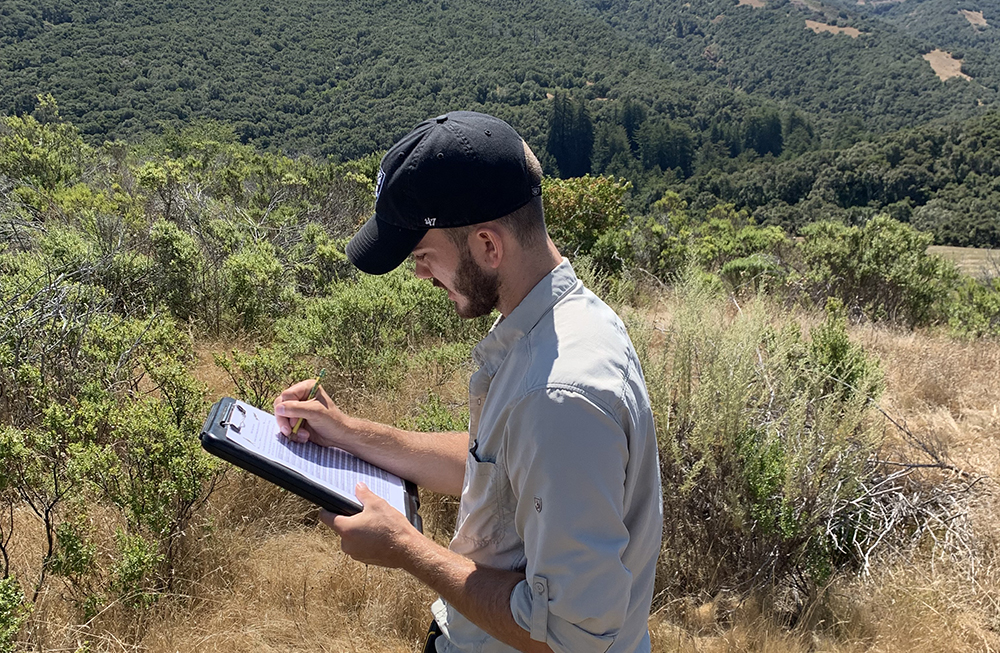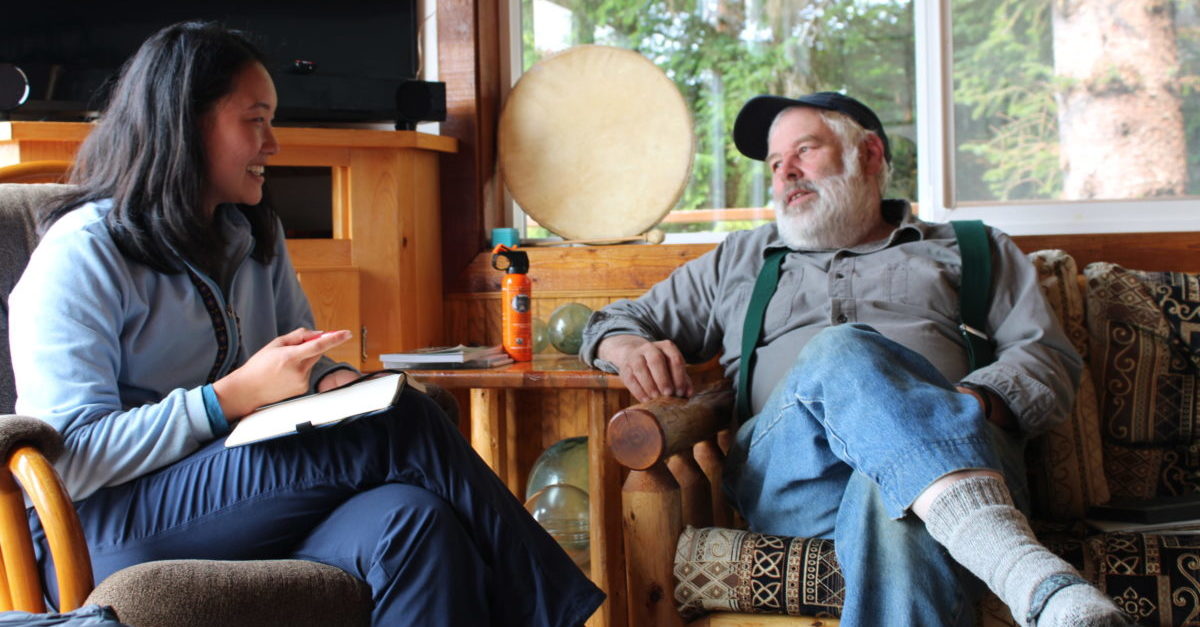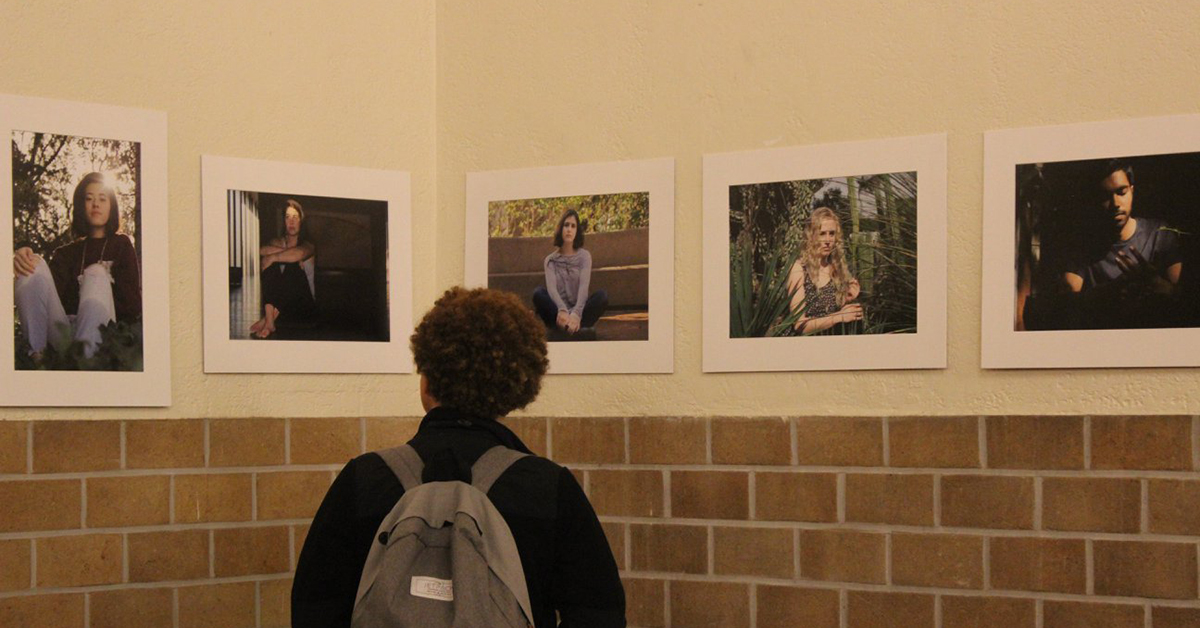Category: Arts & Media

Flying Solo at the Santa Lucia Conservancy
By Max Klotz, ’20
When I made it to the trailhead, Hall’s Ridge was still blanketed in mist. I couldn’t see 15 feet from me, let alone the views down into the valleys on either side of the ridge. I used the delay to organize my photos and make sure I knew the location of each photo point, places with distinctive landmarks that could provide a record for evaluating vegetation changes over time.
The morning mist quickly gave way to sun as, seemingly in minutes, the fog layer around me burned off to reveal views all the way to Monterey Bay. Now having the visibility necessary to capture my photographs, I set off on the trail. I spent the rest of the day hiking and taking pictures, not just of my photo points, but also of the hawks and vultures that circled by the trail.
My project at the Santa Lucia Conservancy in Carmel consisted of selecting and replicating historical photographs of the Santa Lucia Preserve to show the land’s changes over time as part of broader ecological conservation efforts. The process for obtaining repeat photographs of each historical picture was intricate. First, I had to carefully select historical photographs that featured distinctive landmarks in the preserve. Then I worked with my supervisor to identify the approximate locations of each historic photo point and map them using waypoints on the MapItFast software. Finding the exact location for each historical photograph and taking current pictures with the same framing were the final and most challenging steps. I had been struck by the beauty of some of the historical photographs on Hall’s Ridge, so I was excited to explore the area. Early on in my internship at the Santa Lucia Conservancy, I had mostly explored the preserve with other employees, but as my project progressed, I came to enjoy the meditative nature of the days I spent on my own. I set out in a company truck with my water, lunch, camera, and stack of historical photographs. Several weeks into my project, I began to make my way around the different photo locations on the preserve to capture what those photo points look like now. In the process of driving and hiking from place to place in search of historic photo locations, I started to become familiar with the land and its intricacies.

As I looked at my photographs at the end of the summer, I realized the project had shown intriguing results. There had been dramatic changes in some areas of the preserve and a dramatic lack of change in others. Through photography, I was able to track brush encroachment on grasslands, lands recovering from fire treatment, and other broad changes over the course of decades.
This hands-on Cardinal Quarter experience has given me an understanding of the power of combining ecological studies with creative work, as well as a desire to continue to use these tools throughout my career.

Originally from Stanford, CA, Max Klotz, ’20, studies human biology with a concentration in environmental studies. Max completed a Cardinal Quarter during the summer of 2019 with the Santa Lucia Conservancy in Carmel, CA. In addition to engaging in a range of hands-on conservation activities, he helped develop a project to reproduce historical photographs of the Santa Lucia Preserve in order to document environmental change over time. View his “Repeat Photography” project on the Santa Lucia Conservancy website.

Our Islands, Our Stories: Oral History and Community-Building in Southeast Alaska
By Regina Kong, ’22
We were inside Taiga’s fishing boat, docked at the back of the cove. I remember taking a deep breath before setting the voice recorder down on the wooden table. The boat swayed side to side with the afternoon currents. Behind Taiga, I could see thickets of salmonberries and wild blueberries. According to the locals, the dense vegetation sheltered bears that roamed the island. I began the interview by asking Taiga about his childhood, and from there, I followed him as he spoke about everything from commercial fishing to ecology to fatherhood. To this day, everything about that experience and that summer feels entirely surreal.
Taiga was one of 15 people I interviewed for an oral history project I conducted through an internship with the Inian Islands Institute, a nonprofit experiential field school in Southeast Alaska that engages students in climate advocacy and sustainability. I found Inian as if by fate. When I reached out to Inian’s director, Zach Brown, PhD ’14, a few months prior to the summer of 2019, I learned that they had wanted to do an oral history project for a while, but had never had the capacity to do so.
“Do you think you would like to do this?” Zach asked me during one of our initial phone calls.
“Absolutely,” I said.
From a young age, I have always loved stories, especially those involving multiple generations and cultures. When I began thinking about interning with Inian, I was halfway through my freshman year and already thinking deeply about what a true education meant and what forms of wisdom could be attained outside of the traditional classroom—questions that I discovered resonated with Inian’s own mission.
And that was how, not even a week after the last day of school, I found myself in the breathtaking Southeast Alaskan wilderness, surrounded by endless swathes of forest and ocean. For the rest of the summer, I traveled by boat or seaplane to various communities, collecting stories surrounding the island’s homestead, fondly known by local fishermen as the “Hobbit Hole.” My goal was to preserve important community narratives containing such rich anthropological, ecological, and cultural histories; in the process of doing so, I realized that I was also preserving something much deeper.
Oral histories are a methodology for recording and preserving information not found in written records. Because they are shaped by the contours of an individual’s experience and reflections, they allow for the unearthing of rich and often unexpected stories. While these interviews proved emotionally intense, they also taught me how to listen deeply, how to be fully present. I heard incredible stories and met the wisest and most generous people. Strangers like Taiga shared their homes and lives with me, and I will always be grateful for that. From the changing climate in Southeast Alaska to the area’s geologic history to diverse definitions of home, I found myself continually learning more about this unique community as well as discovering a greater human narrative of love, endurance, and connection.
I know this summer will continue to shape who I am for the rest of my life, and I hope to take these stories and gleams of wisdom with me wherever I am in the world. To Taiga and everyone else who made this experience as special as it was and continues to be, thank you from the bottom of my heart.

Regina Kong, ’22, is from Berkeley, California, and is currently studying comparative literature and art practice at Stanford. She spent the summer of 2019 gathering oral histories from locals in Southeast Alaska as part of the Donald Kennedy Summer Projects Cardinal Quarter fellowship with the Inian Islands Institute. At Stanford, Regina serves as a producer for the Stanford Storytelling Project and works as a student tour guide.

Seeing the invisible
By Jenn Ampey, ’19 (International Relations)
The last strand of decorative lights fell into place as the clock struck 7:00 pm. After more than nine months of hard work, it was time to open the doors to “Kaleidoscope: Mental Health Coming into Focus.”
As students filed in, I couldn’t help but stare in awe at the number of students that had come to immerse themselves in the mental health experiences of their peers through art. Many visiting students stayed for upwards of an hour. As co-president of Stanford Mental Health Outreach, I have long had the privilege of engaging with students and faculty across campus on mental health issues. However, the art showcase was a new venture. It involved more than 60 non-members, including student artists and the students photographed. Without them, SMHO would not have been able to host such a moving gallery.

We need to continue to have provocative interactions around mental health issues. Doing so with different media is one more way to reach out to our peers and offer our experiences in an effort to destigmatize conversations that could make an enduring difference in someone’s life.
As the event drew to a close, surrounded by artistic expressions of sometimes indescribable human experiences, my co-president and I found comfort in the realization that we helped build bridges—bridges that we hope will be crossed again and again at Stanford going forward.
Jenn was a Peer Advisor at the Haas Center in 2017-18, in addition to her work with SMHO.
